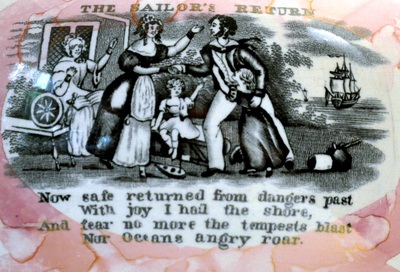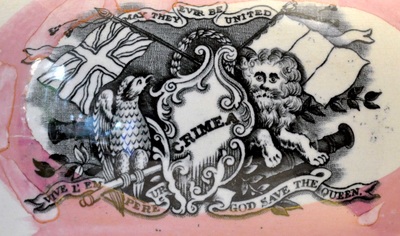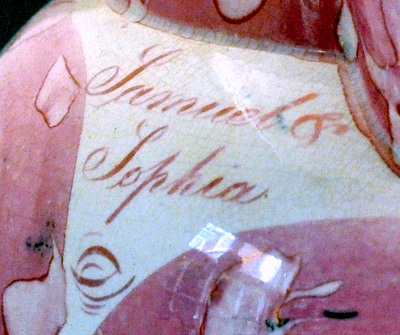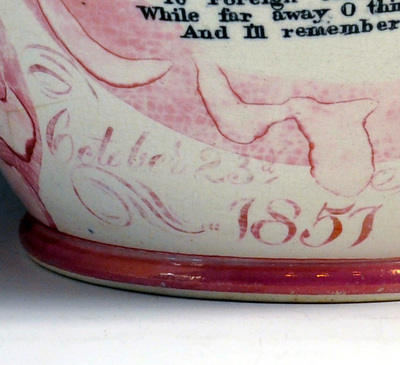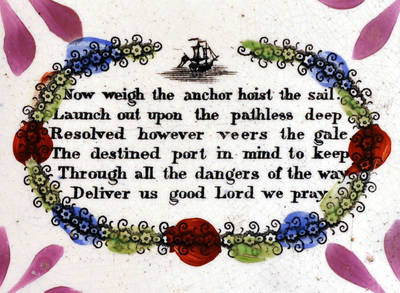|
8/15/2015 0 Comments A Maling copper transfer plateThanks to Ian Sharp for drawing my attention to a copper transfer plate used by Maling, and given to the Laing Art Gallery by Frederick Maling in 1938 (see Moore and Ross, 'Maling - The Trade Mark of Excellence'). Huge thanks also to Sarah Richardson and Amy Barker at Tyne and Wear Museums for processing my request for an image so quickly. Here it is. It is similar to one I wrote about a year ago in the Sunderland Museum, except that it includes the 'Crimea' transfer. The transfers of the Sailor's Farwell and Return are almost identical to the versions used by Moore's in Sunderland (more on that later). But this transfer plate comes from Tyneside. The transfers appear on a fabulous wedding jug I picked up a year ago (click to enlarge and move between the images below). The jug is unmarked, but has a date inscription of 1857. The images are difficult to compare, but after an hour of squinting at photos, I'm satisfied the transfers on my jug originate from this copper plate. When flicking from image to image, please bear in mind that the jugs' transfers have been applied to a curved surface, which distorts the imprint here and there. Giving the jug a firm Maling attribution helps with a plaque I'd been wondering about. Both Maling and Fell used versions of the bridge transfer below. But the similarity of decoration with the jug (see images below) makes me more confident of a Maling attribution. As promised above, here are Moore's (Sunderland) versions of the same transfers. Very similar at first glance, but clearly from another transfer plate. So there are at least 4 similar versions of this group of transfers (Maling, Moore, Scott and the transfer plate donated by the Ball's family to the Sunderland Museum). Finally, below is mug made by Maling in the 1930s with imprints from the same transfer plate. Thanks to Ian Sharp for the photos below. Ian sold the cup as a reproduction and writes: The mug was produced for a London retailer during the 1930s. Many other items within this range were produced including Masonic jugs, plates, bowls and frog mugs. Many of these pieces were frequently unmarked, as requested by the retailer! Many, however, were produced bearing the Maling Castle mark which was used during the period. The transfers were taken from the original 19th century copper plate which was in Maling’s possession. To the untrained eye, this mug looks to be a typical 19th century piece. However, the lustre application is not typical with that of an earlier piece, the colour is also “wrong”. The handle is shaped and moulded to the body as opposed to being applied seperately. The shape and size of the mug does look typical of an earlier piece. Less reputable or less knowledgeable dealers, and even auctions houses, frequently pass these items off for 19th century originals. At the time of writing there is a masonic bowl on eBay with a price tag of almost $1000. Buyer beware!
0 Comments
Leave a Reply. |
AuthorStephen Smith lives in London, and is always happy to hear from other collectors. If you have an interesting collection of plaques, and are based in the UK, he will photograph them for you. Free advice given regarding selling and dispersal of a collection, or to those wishing to start one. Just get in touch... Archives
February 2022
AcknowledgementsThis website is indebted to collectors, dealers and enthusiasts who have shared their knowledge or photos. In particular: Ian Holmes, Stephen Duckworth, Dick Henrywood, Norman Lowe, Keith Lovell, Donald H Ryan, Harold Crowder, Jack and Joyce Cockerill, Myrna Schkolne, Elinor Penna, Ian Sharp, Shauna Gregg at the Sunderland Museum, Keith Bell, Martyn Edgell, and Liz Denton.
|







